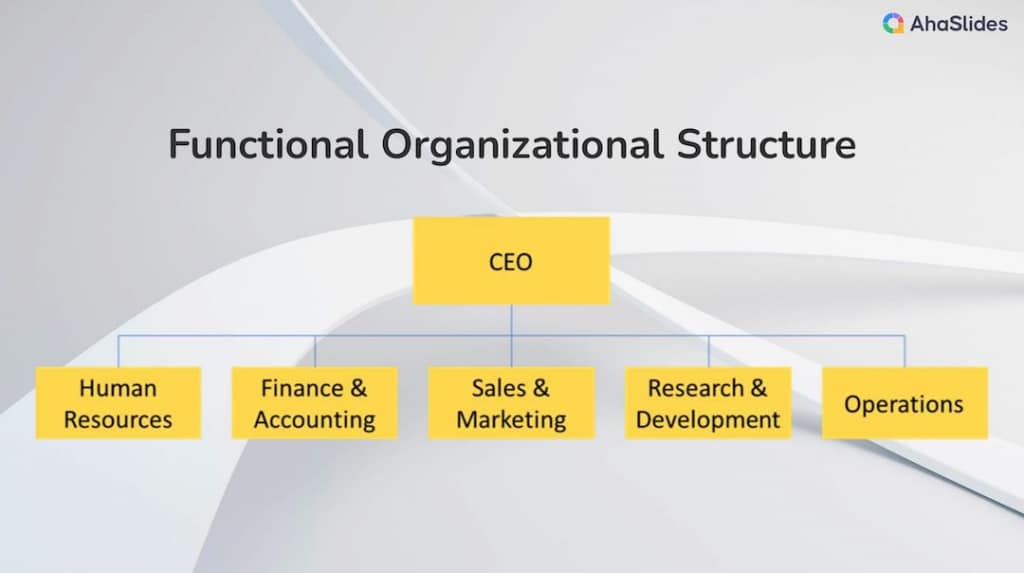![]() සියලුම චලනය වන කොටස් මධ්යයේ විශාල සමාගම් සංවිධානය වන්නේ කෙසේදැයි ඔබ කවදා හෝ කල්පනා කර තිබේද?
සියලුම චලනය වන කොටස් මධ්යයේ විශාල සමාගම් සංවිධානය වන්නේ කෙසේදැයි ඔබ කවදා හෝ කල්පනා කර තිබේද?
![]() සමහර ව්යාපාර එක් ඒකාබද්ධ ඒකකයක් ලෙස ක්රියාත්මක වන අතර බොහෝ ව්යාපාර ක්රියාකාරිත්වය මත පදනම්ව වෙනස් දෙපාර්තමේන්තු ස්ථාපිත කරයි. මෙය හඳුන්වනු ලබන්නේ a
සමහර ව්යාපාර එක් ඒකාබද්ධ ඒකකයක් ලෙස ක්රියාත්මක වන අතර බොහෝ ව්යාපාර ක්රියාකාරිත්වය මත පදනම්ව වෙනස් දෙපාර්තමේන්තු ස්ථාපිත කරයි. මෙය හඳුන්වනු ලබන්නේ a ![]() ක්රියාකාරී ආයතනික ව්යුහය.
ක්රියාකාරී ආයතනික ව්යුහය.
![]() එය අලෙවිකරණය, මූල්ය, මෙහෙයුම්, හෝ තොරතුරු තාක්ෂණ වේවා, ක්රියාකාරී ව්යුහයන් විශේෂත්වය අනුව කණ්ඩායම් කොටස් කරයි.
එය අලෙවිකරණය, මූල්ය, මෙහෙයුම්, හෝ තොරතුරු තාක්ෂණ වේවා, ක්රියාකාරී ව්යුහයන් විශේෂත්වය අනුව කණ්ඩායම් කොටස් කරයි.
![]() මතුපිටින්, මෙම රාජකාරි වෙන් කිරීම පැහැදිලිව පෙනේ - නමුත් එය සහයෝගීතාවය, තීරණ ගැනීම සහ සමස්ත ව්යාපාරයට සැබවින්ම බලපාන්නේ කෙසේද?
මතුපිටින්, මෙම රාජකාරි වෙන් කිරීම පැහැදිලිව පෙනේ - නමුත් එය සහයෝගීතාවය, තීරණ ගැනීම සහ සමස්ත ව්යාපාරයට සැබවින්ම බලපාන්නේ කෙසේද?
![]() මෙම ලිපියෙන් අපි ක්රියාකාරී ආකෘතිය සහ එහි ප්රතිලාභ පිළිබඳ ආවරණය යටතේ බලමු. කෙලින්ම කිමිදෙන්න!
මෙම ලිපියෙන් අපි ක්රියාකාරී ආකෘතිය සහ එහි ප්රතිලාභ පිළිබඳ ආවරණය යටතේ බලමු. කෙලින්ම කිමිදෙන්න!
 අන්තර්ගත වගුව
අන්තර්ගත වගුව
 ක්රියාකාරී ආයතනික ව්යුහයක් යනු කුමක්ද?
ක්රියාකාරී ආයතනික ව්යුහයක් යනු කුමක්ද? ක්රියාකාරී ආයතනික ව්යුහයේ වාසි
ක්රියාකාරී ආයතනික ව්යුහයේ වාසි ක්රියාකාරී ආයතනික ව්යුහයේ අවාසි
ක්රියාකාරී ආයතනික ව්යුහයේ අවාසි ක්රියාකාරී ආයතනික ව්යුහයේ අභියෝග ජය ගැනීම
ක්රියාකාරී ආයතනික ව්යුහයේ අභියෝග ජය ගැනීම ක්රියාකාරී ව්යුහයක් සුදුසු වන්නේ කවදාද?
ක්රියාකාරී ව්යුහයක් සුදුසු වන්නේ කවදාද? ක්රියාකාරී ආයතනික ව්යුහයේ උදාහරණ
ක්රියාකාරී ආයතනික ව්යුහයේ උදාහරණ යතුරු රැගෙන යාම
යතුරු රැගෙන යාම නිතර අසන ප්රශ්න
නිතර අසන ප්රශ්න
 AhaSlides සමඟ තවත් ඉඟි
AhaSlides සමඟ තවත් ඉඟි

 රැස්වීම් අතරතුර තවත් විනෝදයක් සොයනවාද?
රැස්වීම් අතරතුර තවත් විනෝදයක් සොයනවාද?
![]() AhaSlides හි විනෝදාත්මක ප්රශ්නාවලියකින් ඔබේ කණ්ඩායම් සාමාජිකයින් එක්රැස් කරන්න. AhaSlides අච්චු පුස්තකාලයෙන් නොමිලේ ප්රශ්නාවලිය ලබා ගැනීමට ලියාපදිංචි වන්න!
AhaSlides හි විනෝදාත්මක ප්රශ්නාවලියකින් ඔබේ කණ්ඩායම් සාමාජිකයින් එක්රැස් කරන්න. AhaSlides අච්චු පුස්තකාලයෙන් නොමිලේ ප්රශ්නාවලිය ලබා ගැනීමට ලියාපදිංචි වන්න!
 ක්රියාකාරී ආයතනික ව්යුහයක් යනු කුමක්ද?
ක්රියාකාරී ආයතනික ව්යුහයක් යනු කුමක්ද?

 ක්රියාකාරී ආයතනික ව්යුහයක් යනු කුමක්ද?
ක්රියාකාරී ආයතනික ව්යුහයක් යනු කුමක්ද?![]() බොහෝ සමාගම් මිනිසුන් කරන රැකියා වර්ග හෝ කාර්යයන් මත පදනම්ව විවිධ දෙපාර්තමේන්තු වලට සංවිධානය වීමට තෝරා ගනී, වැඩ වඩාත් විශේෂිත රැකියා වලට බෙදා ඇත.
බොහෝ සමාගම් මිනිසුන් කරන රැකියා වර්ග හෝ කාර්යයන් මත පදනම්ව විවිධ දෙපාර්තමේන්තු වලට සංවිධානය වීමට තෝරා ගනී, වැඩ වඩාත් විශේෂිත රැකියා වලට බෙදා ඇත.
![]() මෙය "ඇති" ලෙස හැඳින්වේ.
මෙය "ඇති" ලෙස හැඳින්වේ.![]() ක්රියාකාරී ආයතනික ව්යුහය
ක්රියාකාරී ආයතනික ව්යුහය![]() ". එකම ව්යාපෘතියේ වැඩ කරන සියලු දෙනා එකට එකතු කරනවා වෙනුවට, මිනිසුන් ඔවුන්ගේ කාර්යයේ සාමාන්ය ක්ෂේත්රය අනුව කාණ්ඩගත කරනු ලැබේ - අලෙවිකරණය, මූල්ය, මෙහෙයුම්, පාරිභෝගික සේවා වැනි දේවල්.
". එකම ව්යාපෘතියේ වැඩ කරන සියලු දෙනා එකට එකතු කරනවා වෙනුවට, මිනිසුන් ඔවුන්ගේ කාර්යයේ සාමාන්ය ක්ෂේත්රය අනුව කාණ්ඩගත කරනු ලැබේ - අලෙවිකරණය, මූල්ය, මෙහෙයුම්, පාරිභෝගික සේවා වැනි දේවල්.
![]() උදාහරණයක් ලෙස, වෙළඳ දැන්වීම් නිර්මාණය කරන, සමාජ මාධ්ය ප්රචාරණ ක්රියාත්මක කරන හෝ නව නිෂ්පාදන අදහස් ගැන සිතන සෑම කෙනෙකුම අලෙවිකරණ දෙපාර්තමේන්තුවේ සිටී. මුදල් නිරීක්ෂණය කරන, බිල්පත් ගෙවන සහ බදු ගොනු කරන සියලුම ගණකාධිකාරීවරු මූල්ය කටයුතුවලදී එකට සිටිති. ඉංජිනේරුවන් මෙහෙයුම් වලදී අනෙකුත් ඉංජිනේරුවන් සමඟ වැඩ කරනු ඇත.
උදාහරණයක් ලෙස, වෙළඳ දැන්වීම් නිර්මාණය කරන, සමාජ මාධ්ය ප්රචාරණ ක්රියාත්මක කරන හෝ නව නිෂ්පාදන අදහස් ගැන සිතන සෑම කෙනෙකුම අලෙවිකරණ දෙපාර්තමේන්තුවේ සිටී. මුදල් නිරීක්ෂණය කරන, බිල්පත් ගෙවන සහ බදු ගොනු කරන සියලුම ගණකාධිකාරීවරු මූල්ය කටයුතුවලදී එකට සිටිති. ඉංජිනේරුවන් මෙහෙයුම් වලදී අනෙකුත් ඉංජිනේරුවන් සමඟ වැඩ කරනු ඇත.
![]() අදහස නම් සමාන රැකියා නිපුණතා ඇති සියල්ලන්ම එකට තැබීමෙන්, ඔවුන් එකිනෙකාට උපකාර කිරීමට සහ එකිනෙකාගේ විශේෂඥතාවයෙන් ඉගෙන ගත හැකිය. මූල්ය ක්රියා පටිපාටි වැනි දේවල් ද මුළු දෙපාර්තමේන්තුව පුරාම ප්රමිතිගත කළ හැක.
අදහස නම් සමාන රැකියා නිපුණතා ඇති සියල්ලන්ම එකට තැබීමෙන්, ඔවුන් එකිනෙකාට උපකාර කිරීමට සහ එකිනෙකාගේ විශේෂඥතාවයෙන් ඉගෙන ගත හැකිය. මූල්ය ක්රියා පටිපාටි වැනි දේවල් ද මුළු දෙපාර්තමේන්තුව පුරාම ප්රමිතිගත කළ හැක.
![]() මෙම ව්යුහය එය ඉතා කාර්යක්ෂම කරයි, මන්ද විශේෂඥයින්ට ඔවුන්ගේ දෙපාර්තමේන්තුවෙන් පිටත පිළිතුරු සෙවීමට නිරතුරුවම අවශ්ය නොවේ. නමුත් බොහෝ කුසලතා අවශ්ය වන විශාල ව්යාපෘති සඳහා හොඳින් සහයෝගයෙන් කටයුතු කිරීම විවිධ ප්රදේශවලට ද එය දුෂ්කර විය හැකිය. දෙපාර්තමේන්තු අතර සන්නිවේදනය ද සමහර විට අහිමි විය හැකිය.
මෙම ව්යුහය එය ඉතා කාර්යක්ෂම කරයි, මන්ද විශේෂඥයින්ට ඔවුන්ගේ දෙපාර්තමේන්තුවෙන් පිටත පිළිතුරු සෙවීමට නිරතුරුවම අවශ්ය නොවේ. නමුත් බොහෝ කුසලතා අවශ්ය වන විශාල ව්යාපෘති සඳහා හොඳින් සහයෝගයෙන් කටයුතු කිරීම විවිධ ප්රදේශවලට ද එය දුෂ්කර විය හැකිය. දෙපාර්තමේන්තු අතර සන්නිවේදනය ද සමහර විට අහිමි විය හැකිය.
![]() සමස්තයක් වශයෙන්, ක්රියාවලි සකස් කර ඇති ස්ථාපිත සමාගම් සඳහා ක්රියාකාරී ව්යුහයන් යහපත් වේ, නමුත් සමාගම් තමන්ගේම වැඩ කිරීමෙන් වැළකී සිටීම සඳහා දෙපාර්තමේන්තු වශයෙන් ජනතාව එක් කිරීමට ක්රම සොයා ගත යුතුය.
සමස්තයක් වශයෙන්, ක්රියාවලි සකස් කර ඇති ස්ථාපිත සමාගම් සඳහා ක්රියාකාරී ව්යුහයන් යහපත් වේ, නමුත් සමාගම් තමන්ගේම වැඩ කිරීමෙන් වැළකී සිටීම සඳහා දෙපාර්තමේන්තු වශයෙන් ජනතාව එක් කිරීමට ක්රම සොයා ගත යුතුය. ![]() සිලෝස්
සිලෝස්![]() ඉතා වැඩියි.
ඉතා වැඩියි.
 ක්රියාකාරී ආයතනික ව්යුහයේ වාසි
ක්රියාකාරී ආයතනික ව්යුහයේ වාසි

![]() ක්රියාකාරී ආයතනික ව්යුහයේ ප්රධාන ප්රතිලාභ පහතින් ගවේෂණය කෙරේ.
ක්රියාකාරී ආයතනික ව්යුහයේ ප්රධාන ප්රතිලාභ පහතින් ගවේෂණය කෙරේ.
 ශ්රමය පිළිබඳ විශේෂීකරණය - එම කාර්යයන් කෙරෙහි පමණක් අවධානය යොමු කිරීමෙන් මිනිසුන් ඔවුන්ගේ නිශ්චිත කාර්යයේ විශේෂඥතාව ලබා ගනී. මෙය ඉහළ ඵලදායිතාවයක් ඇති කරයි.
ශ්රමය පිළිබඳ විශේෂීකරණය - එම කාර්යයන් කෙරෙහි පමණක් අවධානය යොමු කිරීමෙන් මිනිසුන් ඔවුන්ගේ නිශ්චිත කාර්යයේ විශේෂඥතාව ලබා ගනී. මෙය ඉහළ ඵලදායිතාවයක් ඇති කරයි. ප්රවීණත්වය මධ්යගත කිරීම - එක් එක් දෙපාර්තමේන්තු තුළ සමාන විශේෂඥතාවන් එකට එකතු වී ඇත. සේවකයින්ට එකිනෙකාගෙන් ඉගෙන ගැනීමට සහ සහයෝගය දැක්විය හැකිය.
ප්රවීණත්වය මධ්යගත කිරීම - එක් එක් දෙපාර්තමේන්තු තුළ සමාන විශේෂඥතාවන් එකට එකතු වී ඇත. සේවකයින්ට එකිනෙකාගෙන් ඉගෙන ගැනීමට සහ සහයෝගය දැක්විය හැකිය. භාවිතයන් ප්රමිතිකරණය - වැඩ කිරීමේ පොදු ක්රම එක් එක් ශ්රිතය තුළ ස්ථාවරත්වය සඳහා වර්ධනය කර ලේඛනගත කළ හැක.
භාවිතයන් ප්රමිතිකරණය - වැඩ කිරීමේ පොදු ක්රම එක් එක් ශ්රිතය තුළ ස්ථාවරත්වය සඳහා වර්ධනය කර ලේඛනගත කළ හැක. වාර්තා කිරීමේ පැහැදිලි රේඛා - බහු කළමනාකරුවන්ට අනුකෘති වාර්තා කිරීමකින් තොරව සේවකයින් ඔවුන්ගේ භූමිකාව මත පදනම්ව වාර්තා කරන්නේ කාටද යන්න පැහැදිලිය. මෙය තීරණ ගැනීම විධිමත් කරයි.
වාර්තා කිරීමේ පැහැදිලි රේඛා - බහු කළමනාකරුවන්ට අනුකෘති වාර්තා කිරීමකින් තොරව සේවකයින් ඔවුන්ගේ භූමිකාව මත පදනම්ව වාර්තා කරන්නේ කාටද යන්න පැහැදිලිය. මෙය තීරණ ගැනීම විධිමත් කරයි. සම්පත් නම්යශීලීව වෙන් කිරීම - වෙනස්වන ප්රමුඛතා සහ වැඩ බර මත පදනම්ව ශ්රමය සහ ප්රාග්ධනය දෙපාර්තමේන්තු තුළ වඩාත් පහසුවෙන් එහා මෙහා කළ හැක.
සම්පත් නම්යශීලීව වෙන් කිරීම - වෙනස්වන ප්රමුඛතා සහ වැඩ බර මත පදනම්ව ශ්රමය සහ ප්රාග්ධනය දෙපාර්තමේන්තු තුළ වඩාත් පහසුවෙන් එහා මෙහා කළ හැක. පරිමාණයේ ආර්ථිකය - නිමැවුම් ඒකකයකට පිරිවැය අඩු කරමින් එක් එක් දෙපාර්තමේන්තුව තුළ උපකරණ සහ සේවකයින් වැනි සම්පත් බෙදා ගත හැකිය.
පරිමාණයේ ආර්ථිකය - නිමැවුම් ඒකකයකට පිරිවැය අඩු කරමින් එක් එක් දෙපාර්තමේන්තුව තුළ උපකරණ සහ සේවකයින් වැනි සම්පත් බෙදා ගත හැකිය. කාර්ය සාධනය අධීක්ෂණය කිරීමේ පහසුව - කාර්යයන් වෙන වෙනම පවතින බැවින් දෙපාර්තමේන්තු ප්රමිතික වඩාත් පැහැදිලිව ඉලක්ක සහ ප්රතිඵලවලට සම්බන්ධ කළ හැක.
කාර්ය සාධනය අධීක්ෂණය කිරීමේ පහසුව - කාර්යයන් වෙන වෙනම පවතින බැවින් දෙපාර්තමේන්තු ප්රමිතික වඩාත් පැහැදිලිව ඉලක්ක සහ ප්රතිඵලවලට සම්බන්ධ කළ හැක. වෘත්තීය සංවර්ධන අවස්ථා - සේවකයින්ට ඔවුන්ගේ විශේෂිත ක්ෂේත්රය තුළ භූමිකාවන් අතර ගමන් කිරීමෙන් ඔවුන්ගේ කුසලතා සහ වෘත්තීන් ඉදිරියට ගෙන යා හැකිය.
වෘත්තීය සංවර්ධන අවස්ථා - සේවකයින්ට ඔවුන්ගේ විශේෂිත ක්ෂේත්රය තුළ භූමිකාවන් අතර ගමන් කිරීමෙන් ඔවුන්ගේ කුසලතා සහ වෘත්තීන් ඉදිරියට ගෙන යා හැකිය. කළමනාකරණ සරල කිරීම - එක් එක් දෙපාර්තමේන්තු ප්රධානියාට තනි සමජාතීය ඒකකයක් කෙරෙහි අධිකාරියක් ඇති අතර, කළමනාකරණය අඩු සංකීර්ණ වේ.
කළමනාකරණ සරල කිරීම - එක් එක් දෙපාර්තමේන්තු ප්රධානියාට තනි සමජාතීය ඒකකයක් කෙරෙහි අධිකාරියක් ඇති අතර, කළමනාකරණය අඩු සංකීර්ණ වේ.
![]() එබැවින් සාරාංශයක් ලෙස, ක්රියාකාරී ව්යුහයක් විශේෂීකරණය, ප්රවීණත්වයේ උත්තෝලනය සහ තනි කාර්යයන් තුළ මෙහෙයුම් කාර්යක්ෂමතාව ප්රවර්ධනය කරයි.
එබැවින් සාරාංශයක් ලෙස, ක්රියාකාරී ව්යුහයක් විශේෂීකරණය, ප්රවීණත්වයේ උත්තෝලනය සහ තනි කාර්යයන් තුළ මෙහෙයුම් කාර්යක්ෂමතාව ප්රවර්ධනය කරයි.
 ක්රියාකාරී ආයතනික ව්යුහයේ අවාසි
ක්රියාකාරී ආයතනික ව්යුහයේ අවාසි

![]() කාසියේ අනෙක් පැත්තෙන්, ක්රියාකාරී ආයතනික ව්යුහයක් සම්පූර්ණයෙන්ම දෝෂ රහිත නොවේ. සමාගම් මෙම විභව පසුබෑම් සලකා බැලිය යුතුය:
කාසියේ අනෙක් පැත්තෙන්, ක්රියාකාරී ආයතනික ව්යුහයක් සම්පූර්ණයෙන්ම දෝෂ රහිත නොවේ. සමාගම් මෙම විභව පසුබෑම් සලකා බැලිය යුතුය:
 සිලෝ මානසිකත්වය - දෙපාර්තමේන්තු සමස්ත සංවිධානයේ අරමුණු වලට වඩා තමන්ගේම අරමුණු කෙරෙහි පමණක් අවධානය යොමු කළ හැකිය. මෙය සහයෝගීතාවයට බාධා කරයි.
සිලෝ මානසිකත්වය - දෙපාර්තමේන්තු සමස්ත සංවිධානයේ අරමුණු වලට වඩා තමන්ගේම අරමුණු කෙරෙහි පමණක් අවධානය යොමු කළ හැකිය. මෙය සහයෝගීතාවයට බාධා කරයි. උත්සාහයන් අනුපිටපත් කිරීම - කාර්යයන් හරහා විධිමත් කිරීමට වඩා විවිධ දෙපාර්තමේන්තු තුළ එකම කාර්යයන් නැවත නැවතත් සිදු කළ හැක.
උත්සාහයන් අනුපිටපත් කිරීම - කාර්යයන් හරහා විධිමත් කිරීමට වඩා විවිධ දෙපාර්තමේන්තු තුළ එකම කාර්යයන් නැවත නැවතත් සිදු කළ හැක. මන්දගාමී තීරණ ගැනීම - දෙපාර්තමේන්තු හරහා සිදුවන ගැටළු නිරාකරණය කිරීමට වැඩි කාලයක් ගත වන බැවින් ඒවාට සිලෝස් අතර සම්බන්ධීකරණය අවශ්ය වේ.
මන්දගාමී තීරණ ගැනීම - දෙපාර්තමේන්තු හරහා සිදුවන ගැටළු නිරාකරණය කිරීමට වැඩි කාලයක් ගත වන බැවින් ඒවාට සිලෝස් අතර සම්බන්ධීකරණය අවශ්ය වේ. දුර්වල පාරිභෝගික සේවාව - බහු දෙපාර්තමේන්තු සමඟ අන්තර් ක්රියා කරන පාරිභෝගිකයින්ට නොගැලපෙන හෝ ඛණ්ඩනය වූ අත්දැකීමක් ලැබිය හැකිය.
දුර්වල පාරිභෝගික සේවාව - බහු දෙපාර්තමේන්තු සමඟ අන්තර් ක්රියා කරන පාරිභෝගිකයින්ට නොගැලපෙන හෝ ඛණ්ඩනය වූ අත්දැකීමක් ලැබිය හැකිය. සංකීර්ණ ක්රියාවලි - හරස් ක්රියාකාරී සහයෝගීතාවයක් අවශ්ය කරන වැඩ පටලැවිලි, අකාර්යක්ෂම සහ කලකිරීමට පත් විය හැක.
සංකීර්ණ ක්රියාවලි - හරස් ක්රියාකාරී සහයෝගීතාවයක් අවශ්ය කරන වැඩ පටලැවිලි, අකාර්යක්ෂම සහ කලකිරීමට පත් විය හැක. වෙනස් කිරීමට අනම්යශීලී බව - වෙළඳපල අවශ්යතා වෙනස් වූ විට හෝ නව අවස්ථා ඇති වූ විට ඉක්මනින් සම්පත් මාරු කිරීම සහ පෙළගැස්වීම අපහසුය.
වෙනස් කිරීමට අනම්යශීලී බව - වෙළඳපල අවශ්යතා වෙනස් වූ විට හෝ නව අවස්ථා ඇති වූ විට ඉක්මනින් සම්පත් මාරු කිරීම සහ පෙළගැස්වීම අපහසුය. වෙළෙඳාම ඇගයීමේ දුෂ්කරතා - අන්තර් යැපීම් සැලකිල්ලට නොගෙන ක්රියාකාරී තීරණවල පුළුල් බලපෑම් නොසලකා හැරිය හැක.
වෙළෙඳාම ඇගයීමේ දුෂ්කරතා - අන්තර් යැපීම් සැලකිල්ලට නොගෙන ක්රියාකාරී තීරණවල පුළුල් බලපෑම් නොසලකා හැරිය හැක. සුපරීක්ෂකවරුන් මත අධික ලෙස යැපීම - සේවකයින් විශාල පින්තූර ඉදිරිදර්ශනයක් වර්ධනය කරනවාට වඩා ඔවුන්ගේ දෙපාර්තමේන්තු නායකයා මත දැඩි ලෙස රඳා පවතී.
සුපරීක්ෂකවරුන් මත අධික ලෙස යැපීම - සේවකයින් විශාල පින්තූර ඉදිරිදර්ශනයක් වර්ධනය කරනවාට වඩා ඔවුන්ගේ දෙපාර්තමේන්තු නායකයා මත දැඩි ලෙස රඳා පවතී. අවහිර වූ නවෝත්පාදනය - විවිධ ප්රදේශවලින් ආදානය අවශ්ය වන නව අදහස් සඳහා සහය ලබා ගැනීම දුෂ්කර වේ.
අවහිර වූ නවෝත්පාදනය - විවිධ ප්රදේශවලින් ආදානය අවශ්ය වන නව අදහස් සඳහා සහය ලබා ගැනීම දුෂ්කර වේ.
![]() ක්රියාකාරී සිලෝස්, මන්දගාමී තීරණ ගැනීම සහ සහයෝගීතාව නොමැතිකම මෙම ව්යුහය ඇති සංවිධානයක කාර්යක්ෂමතාව සහ නම්යශීලීභාවය අඩපණ කළ හැකිය.
ක්රියාකාරී සිලෝස්, මන්දගාමී තීරණ ගැනීම සහ සහයෝගීතාව නොමැතිකම මෙම ව්යුහය ඇති සංවිධානයක කාර්යක්ෂමතාව සහ නම්යශීලීභාවය අඩපණ කළ හැකිය.
 ක්රියාකාරී ආයතනික ව්යුහයේ අභියෝග ජය ගැනීම
ක්රියාකාරී ආයතනික ව්යුහයේ අභියෝග ජය ගැනීම
![]() අලෙවිකරණය, විකුණුම් සහ සහාය වැනි විවිධ වැඩ කණ්ඩායම්වලට ඔවුන් සැමවිටම ඔවුන්ගේම කොන් වල සිටී නම් සම්බන්ධ වීමට අපහසු විය හැකිය. නමුත් හුදකලා වීම ඇත්ත වශයෙන්ම දේවල් සිදු කිරීම දුෂ්කර කරයි. අභියෝග ජය ගැනීමට අදහස් කිහිපයක් මෙන්න:
අලෙවිකරණය, විකුණුම් සහ සහාය වැනි විවිධ වැඩ කණ්ඩායම්වලට ඔවුන් සැමවිටම ඔවුන්ගේම කොන් වල සිටී නම් සම්බන්ධ වීමට අපහසු විය හැකිය. නමුත් හුදකලා වීම ඇත්ත වශයෙන්ම දේවල් සිදු කිරීම දුෂ්කර කරයි. අභියෝග ජය ගැනීමට අදහස් කිහිපයක් මෙන්න:
![]() විවිධ ප්රදේශවල ජනතාව සමඟ ව්යාපෘති කරන්න. මෙය සෑම කෙනෙකුම හඳුන්වා දෙන අතර ඔවුන් එකිනෙකාට උපකාර කරයි.
විවිධ ප්රදේශවල ජනතාව සමඟ ව්යාපෘති කරන්න. මෙය සෑම කෙනෙකුම හඳුන්වා දෙන අතර ඔවුන් එකිනෙකාට උපකාර කරයි.
![]() ඒකක බන්ධනයට උදව් කිරීමට පුද්ගලයින් තෝරන්න. නිෂ්පාදන/සේවාදායක කළමනාකරුවන් පත් කරන්න, ඔවුන් සියලු දෙනාම යාවත්කාලීන බෙදා ගන්නා බවටත් ගැටලු විසඳන බවටත් සහතික කර ගනු ඇත.
ඒකක බන්ධනයට උදව් කිරීමට පුද්ගලයින් තෝරන්න. නිෂ්පාදන/සේවාදායක කළමනාකරුවන් පත් කරන්න, ඔවුන් සියලු දෙනාම යාවත්කාලීන බෙදා ගන්නා බවටත් ගැටලු විසඳන බවටත් සහතික කර ගනු ඇත.
![]() හවුල් ඉලක්ක කෙරෙහි අවධානය යොමු කරන්න, සෑම ප්රදේශයක්ම තමන්ගේම දෙයක් කරනවා වෙනුවට, ඔවුන් සියල්ලන්ම සහාය දක්වන විශාල සමාගම් සිහින වටා පෙළගැස්වීම.
හවුල් ඉලක්ක කෙරෙහි අවධානය යොමු කරන්න, සෑම ප්රදේශයක්ම තමන්ගේම දෙයක් කරනවා වෙනුවට, ඔවුන් සියල්ලන්ම සහාය දක්වන විශාල සමාගම් සිහින වටා පෙළගැස්වීම.
![]() HR හෝ IT වැනි අනුපිටපත් භූමිකාවන් ඒකාබද්ධ කරන්න එවිට එක් කණ්ඩායමක් සියලු වැඩවලට එදිරිව බෙදීම් කටයුතු කරයි.
HR හෝ IT වැනි අනුපිටපත් භූමිකාවන් ඒකාබද්ධ කරන්න එවිට එක් කණ්ඩායමක් සියලු වැඩවලට එදිරිව බෙදීම් කටයුතු කරයි.
![]() සිදුවන්නේ කුමක්ද යන්න පිළිබඳව ප්රදේශ කෙටියෙන් එකිනෙක යාවත්කාලීන වන රැස්වීම් සකසන්න. අංකුරයේ නිප් ගැටළු.
සිදුවන්නේ කුමක්ද යන්න පිළිබඳව ප්රදේශ කෙටියෙන් එකිනෙක යාවත්කාලීන වන රැස්වීම් සකසන්න. අංකුරයේ නිප් ගැටළු.

![]() සහයෝගීතා මෙවලම් සඳහා ආයෝජනය කරන්න - අභ්යන්තර ජාල, ලේඛන/ගොනු බෙදාගැනීම, හෝ ව්යාපෘති කළමනාකරණ යෙදුම් වැනි තාක්ෂණයන් සම්බන්ධීකරණයට පහසුකම් සැලසිය හැක.
සහයෝගීතා මෙවලම් සඳහා ආයෝජනය කරන්න - අභ්යන්තර ජාල, ලේඛන/ගොනු බෙදාගැනීම, හෝ ව්යාපෘති කළමනාකරණ යෙදුම් වැනි තාක්ෂණයන් සම්බන්ධීකරණයට පහසුකම් සැලසිය හැක.
![]() නම්යශීලී භ්රමණයන් ප්රවර්ධනය කරන්න. සේවකයින්ට එකිනෙකා වඩා හොඳින් අවබෝධ කර ගැනීමට සහ වෙනස් ඉදිරිදර්ශනයක් වර්ධනය කිරීමට තාවකාලිකව වෙනත් භූමිකාවන් උත්සාහ කිරීමට ඉඩ දෙන්න.
නම්යශීලී භ්රමණයන් ප්රවර්ධනය කරන්න. සේවකයින්ට එකිනෙකා වඩා හොඳින් අවබෝධ කර ගැනීමට සහ වෙනස් ඉදිරිදර්ශනයක් වර්ධනය කිරීමට තාවකාලිකව වෙනත් භූමිකාවන් උත්සාහ කිරීමට ඉඩ දෙන්න.
![]() කණ්ඩායම් වැඩද නිරීක්ෂණය කරන්න. පුද්ගල ජයග්රහණ පමණක් නොව, මිනිසුන් කෙතරම් හොඳින් ඇසුරු කරනවාද සහ කණ්ඩායමේ සමස්ත KPIs ගැන අවධානය යොමු කරන්න. ක්රියාකාරී KPIs පමණක් නොව, සංවිධානාත්මක සහජීවනය කෙරෙහි අවධානය යොමු කිරීමට නායකයින්ට දිරිගැන්වීම් ලබා දෙන්න.
කණ්ඩායම් වැඩද නිරීක්ෂණය කරන්න. පුද්ගල ජයග්රහණ පමණක් නොව, මිනිසුන් කෙතරම් හොඳින් ඇසුරු කරනවාද සහ කණ්ඩායමේ සමස්ත KPIs ගැන අවධානය යොමු කරන්න. ක්රියාකාරී KPIs පමණක් නොව, සංවිධානාත්මක සහජීවනය කෙරෙහි අවධානය යොමු කිරීමට නායකයින්ට දිරිගැන්වීම් ලබා දෙන්න.
![]() අවසාන වශයෙන්, සමාජ අන්තර්ක්රියා දිරිමත් කරන්න, එවිට එක් එක් දෙපාර්තමේන්තු උපකාර සඳහා එකිනෙකා වෙත ළඟා වීමට වඩාත් පහසු වේ. ශ්රිතයන් අන්තර්ක්රියා කිරීමට සහ අන්තර් රඳා පවතින සමස්තයක් ලෙස ක්රියා කිරීමට ක්රම සොයා ගැනීම සිලෝස් බිඳ දැමීමට උපකාරී වේ.
අවසාන වශයෙන්, සමාජ අන්තර්ක්රියා දිරිමත් කරන්න, එවිට එක් එක් දෙපාර්තමේන්තු උපකාර සඳහා එකිනෙකා වෙත ළඟා වීමට වඩාත් පහසු වේ. ශ්රිතයන් අන්තර්ක්රියා කිරීමට සහ අන්තර් රඳා පවතින සමස්තයක් ලෙස ක්රියා කිරීමට ක්රම සොයා ගැනීම සිලෝස් බිඳ දැමීමට උපකාරී වේ.
 AhaSlides සමඟ අයිස් කඩන්න
AhaSlides සමඟ අයිස් කඩන්න
![]() AhaSlides හි අන්තර් ක්රියාකාරකම් සමඟ සම්බන්ධ වීමට සහ බැඳීමට එක් එක් දෙපාර්තමේන්තුවට උදවු කරන්න. සමාගම්වල බැඳුම්කර සැසි සඳහා අත්යවශ්යයි!🤝
AhaSlides හි අන්තර් ක්රියාකාරකම් සමඟ සම්බන්ධ වීමට සහ බැඳීමට එක් එක් දෙපාර්තමේන්තුවට උදවු කරන්න. සමාගම්වල බැඳුම්කර සැසි සඳහා අත්යවශ්යයි!🤝

 ක්රියාකාරී ව්යුහයක් සුදුසු වන්නේ කවදාද?
ක්රියාකාරී ව්යුහයක් සුදුසු වන්නේ කවදාද?

![]() මෙම ව්යුහය සැකසීමට ඔබේ සංවිධානය සුදුසු දැයි බැලීමට ලැයිස්තුව පරීක්ෂා කරන්න:
මෙම ව්යුහය සැකසීමට ඔබේ සංවිධානය සුදුසු දැයි බැලීමට ලැයිස්තුව පරීක්ෂා කරන්න:
![]() ☐ ප්රමිතිගත මෙහෙයුම් සහිත ස්ථාපිත සමාගම් - මූලික ක්රියාවලි සහ කාර්ය ප්රවාහයන් මනාව නිර්වචනය කර ඇති පරිණත සමාගම් සඳහා, කාර්යයන් තුළ විශේෂීකරණය කාර්යක්ෂමතාව ප්රවර්ධනය කළ හැකිය.
☐ ප්රමිතිගත මෙහෙයුම් සහිත ස්ථාපිත සමාගම් - මූලික ක්රියාවලි සහ කාර්ය ප්රවාහයන් මනාව නිර්වචනය කර ඇති පරිණත සමාගම් සඳහා, කාර්යයන් තුළ විශේෂීකරණය කාර්යක්ෂමතාව ප්රවර්ධනය කළ හැකිය.
![]() ☐ ස්ථාවර ව්යාපාරික පරිසරය - වෙළඳපල සහ පාරිභෝගික අවශ්යතා සාපේක්ෂව පුරෝකථනය කළ හැකි නම්, ක්රියාකාරී කණ්ඩායම් වලට වේගවත් හරස් දෙපාර්තමේන්තු සහයෝගීතාවයකින් තොරව තම විශේෂඥ ක්ෂේත්ර ප්රශස්ත කිරීම කෙරෙහි අවධානය යොමු කළ හැකිය.
☐ ස්ථාවර ව්යාපාරික පරිසරය - වෙළඳපල සහ පාරිභෝගික අවශ්යතා සාපේක්ෂව පුරෝකථනය කළ හැකි නම්, ක්රියාකාරී කණ්ඩායම් වලට වේගවත් හරස් දෙපාර්තමේන්තු සහයෝගීතාවයකින් තොරව තම විශේෂඥ ක්ෂේත්ර ප්රශස්ත කිරීම කෙරෙහි අවධානය යොමු කළ හැකිය.
![]() ☐ කැපවූ ප්රවීණත්වය අවශ්ය කාර්යයන් - ඉංජිනේරු, ගිණුම්කරණය හෝ නීතිමය කටයුතු වැනි ඇතැම් රැකියා ගැඹුරු තාක්ෂණික කුසලතා මත දැඩි ලෙස රඳා පවතින අතර ක්රියාකාරී ව්යුහයකට හොඳින් ගැලපේ.
☐ කැපවූ ප්රවීණත්වය අවශ්ය කාර්යයන් - ඉංජිනේරු, ගිණුම්කරණය හෝ නීතිමය කටයුතු වැනි ඇතැම් රැකියා ගැඹුරු තාක්ෂණික කුසලතා මත දැඩි ලෙස රඳා පවතින අතර ක්රියාකාරී ව්යුහයකට හොඳින් ගැලපේ.
![]() ☐ මෙහෙයුම් ක්රියාත්මක කිරීමට ප්රමුඛත්වය දීම - ආයතනය නිෂ්පාදනයක් හෝ සේවාවක් නිෂ්පාදනය කිරීමට හෝ බෙදා හැරීමට ප්රමුඛත්වය දෙන විට ක්රියාකාරී ව්යුහයන් අතිශයින් කාර්යක්ෂම වේ; කාර්යයන් අතර විශේෂිත පියවර වෙන් කිරීම ක්රියාත්මක කිරීම විධිමත් කළ හැක.
☐ මෙහෙයුම් ක්රියාත්මක කිරීමට ප්රමුඛත්වය දීම - ආයතනය නිෂ්පාදනයක් හෝ සේවාවක් නිෂ්පාදනය කිරීමට හෝ බෙදා හැරීමට ප්රමුඛත්වය දෙන විට ක්රියාකාරී ව්යුහයන් අතිශයින් කාර්යක්ෂම වේ; කාර්යයන් අතර විශේෂිත පියවර වෙන් කිරීම ක්රියාත්මක කිරීම විධිමත් කළ හැක.
![]() ☐ පරිමාණ සහිත විශාල සංවිධාන - දහස් ගණනක් සේවකයින් සිටින ඉතා විශාල සමාගම් බහු ව්යාපාරික ඒකක හරහා සංකීර්ණත්වය කළමනාකරණය කිරීම සඳහා පමණක් කාර්යයන් ලෙස සංවිධානය විය හැක.
☐ පරිමාණ සහිත විශාල සංවිධාන - දහස් ගණනක් සේවකයින් සිටින ඉතා විශාල සමාගම් බහු ව්යාපාරික ඒකක හරහා සංකීර්ණත්වය කළමනාකරණය කිරීම සඳහා පමණක් කාර්යයන් ලෙස සංවිධානය විය හැක.
![]() ☐ සම්පත් වෙන් කිරීම වඩාත් වැදගත් වේ - ප්රාග්ධන-අවශ්ය කර්මාන්ත සඳහා, විශේෂිත සම්පත් සහ උපකරණ නිවැරදිව වෙන් කිරීමට පහසුකම් සපයන ව්යුහයක් හොඳින් ක්රියා කරයි.
☐ සම්පත් වෙන් කිරීම වඩාත් වැදගත් වේ - ප්රාග්ධන-අවශ්ය කර්මාන්ත සඳහා, විශේෂිත සම්පත් සහ උපකරණ නිවැරදිව වෙන් කිරීමට පහසුකම් සපයන ව්යුහයක් හොඳින් ක්රියා කරයි.
![]() ☐ සාම්ප්රදායිකව නිලධාරිවාදී සංස්කෘතීන් - සමහර ස්ථාපිත සමාගම් පාලනය සහ අධීක්ෂණය සඳහා ඉහළ දෙපාර්තමේන්තුගත සැකසුම් වලට කැමැත්තක් දක්වයි.
☐ සාම්ප්රදායිකව නිලධාරිවාදී සංස්කෘතීන් - සමහර ස්ථාපිත සමාගම් පාලනය සහ අධීක්ෂණය සඳහා ඉහළ දෙපාර්තමේන්තුගත සැකසුම් වලට කැමැත්තක් දක්වයි.
 ක්රියාකාරී ආයතනික ව්යුහයේ උදාහරණ
ක්රියාකාරී ආයතනික ව්යුහයේ උදාහරණ

 ක්රියාකාරී සංවිධානයේ උදාහරණයක්.
ක්රියාකාරී සංවිධානයේ උදාහරණයක්.![]() තාක්ෂණ සමාගම:
තාක්ෂණ සමාගම:
 අලෙවිකරණ දෙපාර්තමේන්තුව
අලෙවිකරණ දෙපාර්තමේන්තුව ඉංජිනේරු දෙපාර්තමේන්තුව
ඉංජිනේරු දෙපාර්තමේන්තුව නිෂ්පාදන සංවර්ධන දෙපාර්තමේන්තුව
නිෂ්පාදන සංවර්ධන දෙපාර්තමේන්තුව තොරතුරු තාක්ෂණ/මෙහෙයුම් දෙපාර්තමේන්තුව
තොරතුරු තාක්ෂණ/මෙහෙයුම් දෙපාර්තමේන්තුව විකුණුම් දෙපාර්තමේන්තුව
විකුණුම් දෙපාර්තමේන්තුව පාරිභෝගික සහාය දෙපාර්තමේන්තුව
පාරිභෝගික සහාය දෙපාර්තමේන්තුව
![]() නිෂ්පාදන සමාගම:
නිෂ්පාදන සමාගම:
 නිෂ්පාදන/මෙහෙයුම් දෙපාර්තමේන්තුව
නිෂ්පාදන/මෙහෙයුම් දෙපාර්තමේන්තුව ඉංජිනේරු දෙපාර්තමේන්තුව
ඉංජිනේරු දෙපාර්තමේන්තුව ප්රසම්පාදන දෙපාර්තමේන්තුව
ප්රසම්පාදන දෙපාර්තමේන්තුව තත්ත්ව පාලන දෙපාර්තමේන්තුව
තත්ත්ව පාලන දෙපාර්තමේන්තුව ලොජිස්ටික්ස්/බෙදාහැරීමේ දෙපාර්තමේන්තුව
ලොජිස්ටික්ස්/බෙදාහැරීමේ දෙපාර්තමේන්තුව විකුණුම් සහ අලෙවි දෙපාර්තමේන්තුව
විකුණුම් සහ අලෙවි දෙපාර්තමේන්තුව මුදල් හා ගිණුම් දෙපාර්තමේන්තුව
මුදල් හා ගිණුම් දෙපාර්තමේන්තුව
![]() රෝහල:
රෝහල:
 හෙද අංශය
හෙද අංශය විකිරණ අංශය
විකිරණ අංශය ශල්ය දෙපාර්තමේන්තුව
ශල්ය දෙපාර්තමේන්තුව රසායනාගාර දෙපාර්තමේන්තුව
රසායනාගාර දෙපාර්තමේන්තුව ෆාමසි දෙපාර්තමේන්තුව
ෆාමසි දෙපාර්තමේන්තුව පරිපාලන/බිල්පත් දෙපාර්තමේන්තුව
පරිපාලන/බිල්පත් දෙපාර්තමේන්තුව
![]() සිල්ලර වෙළඳසැල:
සිල්ලර වෙළඳසැල:
 ගබඩා මෙහෙයුම් දෙපාර්තමේන්තුව
ගබඩා මෙහෙයුම් දෙපාර්තමේන්තුව වෙළඳ භාණ්ඩ/මිලදී ගැනීමේ දෙපාර්තමේන්තුව
වෙළඳ භාණ්ඩ/මිලදී ගැනීමේ දෙපාර්තමේන්තුව අලෙවිකරණ දෙපාර්තමේන්තුව
අලෙවිකරණ දෙපාර්තමේන්තුව මුදල්/ගිණුම්කරණ දෙපාර්තමේන්තුව
මුදල්/ගිණුම්කරණ දෙපාර්තමේන්තුව මානව සම්පත් දෙපාර්තමේන්තුව
මානව සම්පත් දෙපාර්තමේන්තුව පාඩු වැළැක්වීමේ දෙපාර්තමේන්තුව
පාඩු වැළැක්වීමේ දෙපාර්තමේන්තුව තොරතුරු තාක්ෂණ දෙපාර්තමේන්තුව
තොරතුරු තාක්ෂණ දෙපාර්තමේන්තුව
![]() විශ්ව විද්යාලය:
විශ්ව විද්යාලය:
 ජීව විද්යාව, ඉංග්රීසි, ඉතිහාසය, වැනි විවිධ අධ්යයන දෙපාර්තමේන්තු
ජීව විද්යාව, ඉංග්රීසි, ඉතිහාසය, වැනි විවිධ අධ්යයන දෙපාර්තමේන්තු ශිෂ්ය කටයුතු දෙපාර්තමේන්තුව
ශිෂ්ය කටයුතු දෙපාර්තමේන්තුව පහසුකම් දෙපාර්තමේන්තුව
පහසුකම් දෙපාර්තමේන්තුව අනුග්රහය දක්වන පර්යේෂණ දෙපාර්තමේන්තුව
අනුග්රහය දක්වන පර්යේෂණ දෙපාර්තමේන්තුව මලල ක්රීඩා දෙපාර්තමේන්තුව
මලල ක්රීඩා දෙපාර්තමේන්තුව මුදල් හා පරිපාලන දෙපාර්තමේන්තුව
මුදල් හා පරිපාලන දෙපාර්තමේන්තුව
![]() ක්රියාකාරී ආයතනික ව්යුහයක් පිහිටුවීම සඳහා විවිධ කර්මාන්තවල සමාගම් විසින් විශේෂිත භූමිකාවන් සහ ක්රියාකාරකම් දෙපාර්තමේන්තුවලට කාණ්ඩගත කළ හැකි ආකාරය පිළිබඳ උදාහරණ කිහිපයක් මේවාය.
ක්රියාකාරී ආයතනික ව්යුහයක් පිහිටුවීම සඳහා විවිධ කර්මාන්තවල සමාගම් විසින් විශේෂිත භූමිකාවන් සහ ක්රියාකාරකම් දෙපාර්තමේන්තුවලට කාණ්ඩගත කළ හැකි ආකාරය පිළිබඳ උදාහරණ කිහිපයක් මේවාය.
 ප්රතිපෝෂණය යනු ආයතනවල ඵලදායී ඵලදායිතාව ඉහළ නංවන තීරණාත්මක සාධකයකි. AhaSlides වෙතින් 'නිර්නාමික ප්රතිපෝෂණ' ඉඟි සමඟ සගයන්ගේ අදහස් සහ සිතුවිලි රැස් කරන්න.
ප්රතිපෝෂණය යනු ආයතනවල ඵලදායී ඵලදායිතාව ඉහළ නංවන තීරණාත්මක සාධකයකි. AhaSlides වෙතින් 'නිර්නාමික ප්රතිපෝෂණ' ඉඟි සමඟ සගයන්ගේ අදහස් සහ සිතුවිලි රැස් කරන්න. යතුරු රැගෙන යාම
යතුරු රැගෙන යාම
![]() විශේෂිත දෙපාර්තමේන්තු වලට වැඩ බෙදීම එහි ප්රතිලාභ ඇති අතර, කණ්ඩායම් අතර සිලෝ සෑදීම පහසුය. ඇත්ත වශයෙන්ම සාර්ථක වීමට නම්, සමාගම්වලට හුදු විශේෂතා තරම් සහයෝගීතාව අවශ්ය වේ.
විශේෂිත දෙපාර්තමේන්තු වලට වැඩ බෙදීම එහි ප්රතිලාභ ඇති අතර, කණ්ඩායම් අතර සිලෝ සෑදීම පහසුය. ඇත්ත වශයෙන්ම සාර්ථක වීමට නම්, සමාගම්වලට හුදු විශේෂතා තරම් සහයෝගීතාව අවශ්ය වේ.
![]() දවස අවසානයේදී අපි හැමෝම එකම කණ්ඩායමේ. ඔබ නිෂ්පාදන නිර්මාණය කළත් හෝ පාරිභෝගික සේවා ලබා දුන්නත්, ඔබේ කාර්යය අන් අයට සහ සමාගමේ සමස්ත මෙහෙවරට සහාය වේ.
දවස අවසානයේදී අපි හැමෝම එකම කණ්ඩායමේ. ඔබ නිෂ්පාදන නිර්මාණය කළත් හෝ පාරිභෝගික සේවා ලබා දුන්නත්, ඔබේ කාර්යය අන් අයට සහ සමාගමේ සමස්ත මෙහෙවරට සහාය වේ.
💡 ![]() මේවාත් බලන්න:
මේවාත් බලන්න: ![]() එම
එම ![]() 7 ආයතනික ව්යුහය වර්ග
7 ආයතනික ව්යුහය වර්ග ![]() ඔබ දැනගත යුතුයි.
ඔබ දැනගත යුතුයි.
 නිතර අසන ප්රශ්න
නිතර අසන ප්රශ්න
![]() 4 ක්රියාකාරී ආයතනික ව්යුහයන් මොනවාද?
4 ක්රියාකාරී ආයතනික ව්යුහයන් මොනවාද?
![]() ක්රියාකාරී ආයතනික ව්යුහයන් හතර වන්නේ ක්රියාකාරී, කොට්ඨාශ, අනුකෘති සහ ජාල ව්යුහයයි.
ක්රියාකාරී ආයතනික ව්යුහයන් හතර වන්නේ ක්රියාකාරී, කොට්ඨාශ, අනුකෘති සහ ජාල ව්යුහයයි.
![]() ක්රියාකාරී ව්යුහය යන්නෙන් අදහස් කරන්නේ කුමක්ද?
ක්රියාකාරී ව්යුහය යන්නෙන් අදහස් කරන්නේ කුමක්ද?
![]() ක්රියාකාරී ආයතනික ව්යුහයක් යනු සමාගමක් ක්රියාත්මක වන විට සම්බන්ධ වන කාර්යයන් හෝ රේඛා මත පදනම්ව එහි ශ්රමය සහ දෙපාර්තමේන්තු බෙදන ආකාරයයි.
ක්රියාකාරී ආයතනික ව්යුහයක් යනු සමාගමක් ක්රියාත්මක වන විට සම්බන්ධ වන කාර්යයන් හෝ රේඛා මත පදනම්ව එහි ශ්රමය සහ දෙපාර්තමේන්තු බෙදන ආකාරයයි.
![]() මැක්ඩොනල්ඩ්ස් යනු ක්රියාකාරී ආයතනික ව්යුහයක්ද?
මැක්ඩොනල්ඩ්ස් යනු ක්රියාකාරී ආයතනික ව්යුහයක්ද?
![]() McDonald's සතුව ප්රාදේශීය සංවිධාන ව්යුහයක් ඇත, එහිදී සෑම අංශයක්ම නිශ්චිත භූගෝලීය ස්ථානයකට සේවය කරන අතර අලෙවිකරණය, විකුණුම්, මූල්ය, නෛතික, සැපයුම සහ එවැනි වෙනම දෙපාර්තමේන්තු සමඟ පාහේ ස්වාධීනව ක්රියාත්මක වේ.
McDonald's සතුව ප්රාදේශීය සංවිධාන ව්යුහයක් ඇත, එහිදී සෑම අංශයක්ම නිශ්චිත භූගෝලීය ස්ථානයකට සේවය කරන අතර අලෙවිකරණය, විකුණුම්, මූල්ය, නෛතික, සැපයුම සහ එවැනි වෙනම දෙපාර්තමේන්තු සමඟ පාහේ ස්වාධීනව ක්රියාත්මක වේ.







